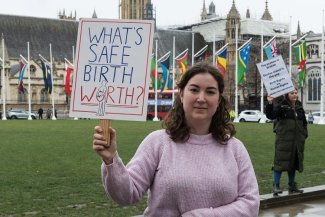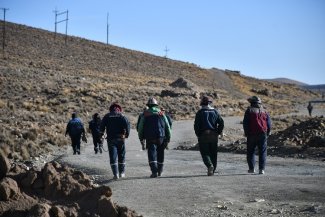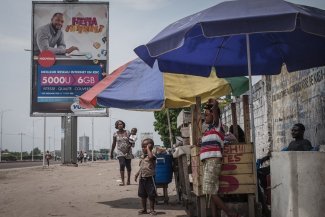Perhaps, in the future, we will see generations that are more distant or better equipped to adapt to unforeseen circumstances. It is not something we can predict, as yet. But what the UN is already forecasting is that this health crisis, which will be followed by a socioeconomic crisis, will lead to an inevitable increase in child poverty around the world.
When the editors of Nature magazine first used the term ‘coronavirus’ in 1968, they probably never, not even in their wildest dreams, imagined that the concept would become part of the everyday vocabulary of a five-year-old girl.
“The coronavirus is bad. It’s outside,” says Nerea, with confidence. She knows that is why she cannot go to school, why she cannot play in the park, why she has to stay home. “So it can’t catch us,” she says. The same story is repeated in millions of homes around the world. New fables have emerged in a time of pandemic, with the virus turned into a villain with green antennae, to warn them – to convince them – not to go out, and to accept making a much greater sacrifice than that asked of the adults.
“Children have seen their lives completely transformed overnight. They have stopped going to school, stopped meeting up with their friends and their relatives. Their confinement is much more severe than ours,” says Almudena Escorial, head of advocacy at the Spanish children’s rights platform, Plataforma de Infancia, a coalition of over 60 organisations dedicated to protecting minors in Spain, the country – along with Italy – where children and adolescents have experienced the strictest restrictions in Europe.
While Spain’s adults were allowed to go out to shop, to walk the dog or to take out the rubbish, its children had to spend more than 40 days in total lockdown. It was not until 26 April that they were allowed out, for an hour, and within a radius of no more than one kilometre from their home. The severity of the measures has been harshly criticised not only by the families but also by specialists in children’s issues.
“This emergency situation is enabling the restriction of everyone’s rights, both adults and children. But we should always assess how it might affect them before taking any kind of measure, because they deserve special protection,” says Clara Martínez, director of the Cátedra Santander de los Derechos del Niño (Santander Chair for Children’s Rights), promoting research, training and knowledge on children’s rights.
Unfortunately, as the United Nations Committee on the Rights of the Child has itself acknowledged, the best interests of children have been ignored during this crisis. Children and adolescents, less affected in principle by the virulence of Covid-19, have been pushed into the background more than ever before, with restrictions designed by and for adults but that are also affecting their rights, their right to education, health, food and safety.
Unequal confinement
“Children are not the face of the pandemic,” the United Nations recalled in a report published in April 2020, noting that their hospitalisation rate for Covid-19 is 10 to 20 times lower. “But they risk being among its biggest victims,” it added.
Sixty per cent of the world’s children live in countries where there is total or partial confinement. It is not equally strict in all states – in Japan, for example, children can continue to play in the streets as long as they keep their distance from others – but the disruption of everyday life tends to affect the little ones as much as adults. They also experience the same emotional side effects: exhaustion, irritability, restlessness and fear. “They are the classic symptoms triggered by uncertainty,” says child psychologist José Antonio Luengo.
According to this specialist, “Most children – those who are living normal everyday lives, in a reasonable home, with space to move around and light, those who eat well and have contact with their teachers through technological tools – are coping reasonably well with the situation and any harmful effects will disappear as things improve.”
But what happens if any of these elements is missing: if there is no light, no space, if they don’t eat well? What happens if there is not enough money even to cover the basics?
In Mexico, for example, almost half of the 40 million children live in poverty, more than nine million lack basic services at home and at least ten million do not have access to sufficient food. “Many of them were eating at school once a day. Their families have to shoulder the cost now, and for many it is just not possible,” explains Juan Martin Perez, director of REDIM, the children’s rights network in Mexico.
In Spain, where one in five children lives in moderate poverty, the unequal impact of confinement on more vulnerable minors is also a cause for concern. Research led by the University of the Basque Country has recently found that children living in lower income households feel more anxious and stressed, consume less fruit and vegetables, get less exercise and are more exposed to tobacco smoke.
“It’s already the case under normal circumstances,” says Maite Morteruel, one of the researchers. “Children from poor families tend to have poorer health. The problem is that uniform confinement measures have been designed, assuming that it would be easy for everyone, but it isn’t.”
And then there is an even more vulnerable, even more invisible group of children: the street children, the unaccompanied migrant children, those with nowhere to retreat. “There are large numbers of homeless children in some parts of Latin America and sub-Saharan Africa,” says Nadia Criado, head of international programmes at Save the Children. “They are at a higher risk than those who are confined, because they are alone and the resources previously available to them, such as canteens or day centres, have also been forced to close. The impact on them is expected to be much greater.”
Locked in with the enemy
There are even darker sides to confinement. In a world where almost 300 million children aged two to four routinely experience violent discipline at the hands of their caregivers, where one in four under-fives lives with a mother suffering from intimate partner violence, confinement not only prevents them from leaving the house, it also forces them to live with their potential abuser around the clock.
“There is an increase in level of violence,” says Martínez. “Under normal circumstances, between 70 and 80 per cent of violence against children, whether sexual or non-sexual, usually occurs within the home. Now that the stress on the whole family is greater, the risk of violence is also greater. It’s a pressure cooker, with the added difficulty that children now have less access to the reporting channels usually available to them.”
The risk is greater in countries where violence had already reached epidemic proportions long before Covid-19 came on the scene.
“Mexico is confronting this crisis with a very poor child protection system and with considerable difficulty identifying violence against children,” warns Save the Children advocacy coordinator Mariana Pria. In March, a historic record of 20,232 cases of domestic violence were reported, 12 per cent more than the previous month. There was also an 11 per cent increase in the number of sexual abuse cases, in which the vast majority of the victims are girls.
Past health emergencies, such as the Ebola crisis that hit west Africa between 2014 and 2016, should serve as a warning. In countries such as Sierra Leone, sexual violence and the risk of pregnancy amongst 12 to 17-year-old girls more than doubled in the villages most affected by the virus.
The risk of being left behind
Since the start of the health crisis, 186 countries have imposed temporary school closures and nearly 74 per cent of the world’s children and young people have stopped attending conventional face-to-face classes, according to UNESCO. Some 1.2 billion schoolchildren are now trying to continue their education via the internet, radio, television or telephone messaging systems.
According to the United Nations, more than two-thirds of the countries that have closed their classrooms have set up distance learning platforms but in lower income countries the rate of participation is only 30 per cent.
Education is central to correcting inequalities, but with COVID-19 that key has been broken. And this is where the virus exposes problems that existed before the pandemic. The digital divide, which affects some 346 million children and adolescents, is one such problem. Another is the difficulty many parents have in giving their children help and support, either because they lack the time or the knowledge.
UNICEF has already called on states to reinforce their school support programmes and, above all, to reduce educational requirements during the crisis, so that no one is left behind. The situation represents a real challenge for highly competitive societies such as South Korea or Japan, where children can spend up to 10 hours a day between regular classes and private tutoring in order to achieve the much sought-after level of excellence.
South Korea is taking advantage of the crisis to begin its transition to virtual education, distributing electronic devices to the neediest families. Japan, by contrast, a country that prides itself on being technologically advanced, has yet to bring online education into the national debate. Only private schools have switched to this new way of teaching. “Unlike private schools, public schools have not invested in technology. We are not prepared, there are no online teaching plans,” complains a Tokyo teacher, who does not wish to be named. “The gap will widen in low-income or single-mother families. It will be difficult to bring pupils back to the same level when they return.”
It is the next stage that teachers and children’s organisations are most worried about: when it’s time to go back, when it’s all over and the schools finally reopen. “In many countries where families are already living in precarious conditions, many of these children will not return to school,” says Criado of Save the Children. “Especially the girls.”
A generational mark
There is no doubt that children and adolescents are suffering from many of the indirect impacts of COVID-19, but what do they have to say about it? Two Spanish sociologists put the question to over 400 children. The result is the first portrait of confined childhood as seen through their eyes.
It is thanks to this that we know, for example, that more than 94 per cent of children consider confinement to be a necessary measure, that most of them often think about their grandparents, that – although almost all of them feel a little bored by now – many are happy to spend time with their parents or to finally be able to manage their free time.
“Children are naturally resilient. They use their own resources to understand confinement and accept it,” says Iván Rodríguez, co-author of the study. “They are also showing more solidarity, with many describing confinement as necessary for the common good.” Some observers are already talking about the mark this unprecedented situation could leave on the current generation of children and young people, already dubbed by some as ‘coronakids’ or ‘pandemials’.
“This generation of children aged between five and 18 might never forget this period, but not so much because of what we have experienced so far, but because of what we are going to experience. A month of confinement may have an impact, but the new social distancing reality is going to last much longer,” says psychologist José Antonio Luengo.
Perhaps, in the future, we will see generations that are more distant or better equipped to adapt to unforeseen circumstances. It is not something we can predict, as yet. But what the UN is already forecasting is that this health crisis, which will be followed by a socioeconomic crisis, will lead to an inevitable increase in child poverty around the world.
According to its estimates, between 42 and 66 million children could fall into extreme poverty as a result of Covid-19. This would be in addition to the almost 385 million children already living in poverty. And not only is the achievement of the sustainable development goals by 2030 at risk, but also the gains already secured, such as the reduction in the infant mortality rate. Polio and measles vaccination drives are already being abandoned in regions with weaker health systems, as all resources are diverted to the fight against the pandemic.
“With the 2008 economic collapse, children became the poorest population group because no specific measures were taken for minors. That’s why we have to start working now to prevent this from happening again,” insists Spain’s children’s rights NGO Plataforma de Infancia. This not only means putting them back at the centre of the debate from which they have been excluded, but also listening to what they have to say.
“Children should understand what is happening and feel that they are taking part in the decisions that are being made in response to the pandemic,” recommended the UN Committee on the Rights of the Child after seeing how seldom political leaders address them in their speeches. Barring a few exceptions, such as Norway or Spain, where specific Q&As have been organised for children, they have been pretty much ignored. Their right to participate, to be informed and heard, has been one of the many rights they have lost during this crisis.
“Thinking about children is always well intentioned, but we think about them from an adult perspective. We tend to consider them as incomplete beings and that is why we decide for them,” says Lourdes Gaitán, founder of the Sociology of Childhood and Adolescence Group (GSIA). The sociologist recalls how the generation we have been ignoring is the same generation that taught the world a lesson by going out to protest about the climate crisis every Friday, the same generation that took to the streets of Chile just a few months ago to rebel against social injustice. It is a generation that, in spite of everything, has long shown that it has a great deal to contribute.
“No one can know what these children will be like in the future. The only thing we can know is how they are now, and we can only know that if we listen to them, if we pay attention to what they have to say.”
With additional reporting from Aitor Sáez in Mexico and Carmen Grau in Japan.










